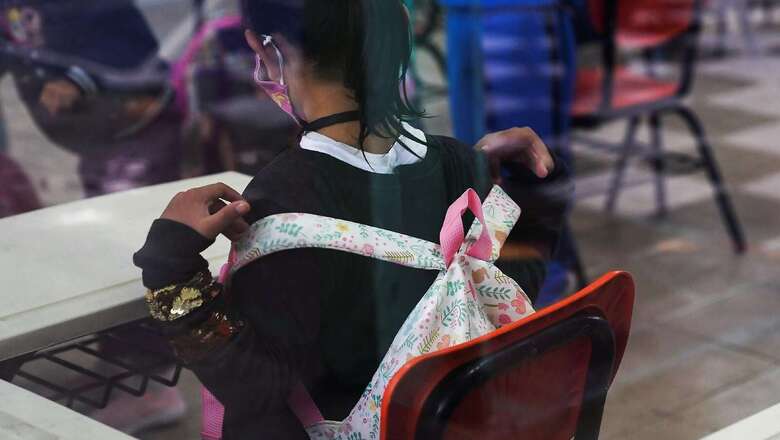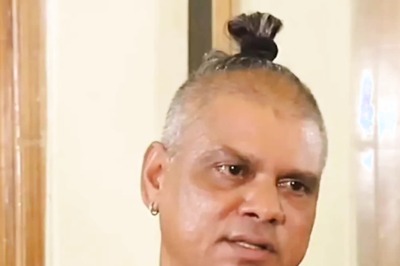
views
Children in India need fresh air, affectionate classrooms, inspiring teachers, open playgrounds and inclusive education in their schools. These are basic child rights that are mandated and not charities of any kind. These help children bond, facilitate emotional development and develop compassion and love.
Scarfs or shawls of any colour are irrelevant and unnecessary today in schools and educational institutes.
Children agitating on the streets for both scarfs and shawls are pawns on a chess board — used by those with vested interests living in safe havens and wanting to further their divisive agendas, just like terrorist groups across the world using children as ‘soldiers’ for their ‘murderous’ armies.
These vested interest groups have no idea about the plight of our children.
Children with Learning Disabilities
There are children who have difficulty reading, writing, speaking, listening to, understanding mathematical concepts. They remain invisible and are seldom identified and understood in India. These children do show signs, like incomplete notebooks, bad handwriting, low grades and poor Maths skills. At least 5 per cent of students suffer from learning disabilities and 99.9 per cent of them remain undiagnosed. Lack of diagnosis is one of the biggest cause for their ‘exclusion from school’ or dropping out. The National Brain Research Centre, India says one-sixth children are different learners who need to be taught differently. Such children are blamed and shamed by both families and schools as lazy, uninterested, truant and mischievous. They lose their self-esteem and feel useless and worthless.
Many of them consequently suffer from depression, engage in unsocial behaviour and drop out. Few have been able to shatter the glass ceiling and rise in life. Some successful examples are Abhishek Bachchan, Steven Spielberg and actor Tom Cruise. However, romanticising these few examples can lead us to believe that every child can rise amidst trauma. For every child with a learning disorder who can rise, there are at least a million who fall aside. India is slow in understanding this issue, forget about identifying it. Taare Zameen Par, the popular Hindi movie backed by and starring Aamir Khan, highlighted and created awareness on the subject some years ago.
Some Shocking Stats
In 2018, 50,876 candidates were registered to appear in Class 12 CBSE exams in the Northeast (Guwahati Centre) of which only four were diagnosed as having learning disabilities, i.e. little more than 0.007 per cent. At least more than 2,500 children went unnoticed and undiagnosed. The Northeast is the worst affected, in this case.
That year, 11,62,645 students appeared for Class 12 exams in India. Only 918 registered as having learning disabilities, 0.07 per cent. At least 57,000 children were missed out.
Among 16,25,967 children appearing for Class 10 exams, 1,571 were registered with learning disabilities. This is just 0.09 per cent. At least 80,000 children were missed being diagnosed.
In 2019, the terminologies were changed. Children with special needs (CWSN) included all categories of disabilities. For Class 10, the CWSN figure stood at 0.29 per cent, for Class 12, it was 0.27 per cent. Both numbers were far away from the estimates suggested by the National Brain Research Centre. In 2020, the figures were 0.31 per cent (for Class 10) and 0.20 per cent (for Class 12).
If one were to exclude disabilities such as autism, cerebral palsy or orthopaedic problems, the figures registered for learning disabilities would be much lower. The statistics for the state boards are worse than CBSE, with lakhs of children undiagnosed.
‘The Children With Specific Learning Disabilities (Identification and Support in Education) Bill,’ was introduced in Rajya Sabha in 2017 and again in 2019. It has revolutionary clauses such as,
(1) The appropriate governments including local-self governments shall conduct an annual survey to identify the number of persons with specific learning disabilities, the nature of facilities and assistance provided to them and the extent to which they are benefitted.
(2) The manner of conduct of survey, qualification of personnel involved in survey, maintenance of records and publication of reports shall be such as may be prescribed.
While this Bill is yet to become a law, there are neither adequate tests nor enough qualified professionals to conduct such tests for screening learning disability. This government has attempted to resolve this.
DALI or Dyslexia Assessment for Languages of India, a screening test launched in 2015 by Dr Harsh Vardhan, then Minister of Science and Technology, is a small beginning, but it has not yet evolved effective tools for majority of the languages to be used by professionals or teachers.
All those who are at war over hijab need to know that there are 28,276 Urdu schools in the country and no DALI tests are available in Urdu to date. Those who counter with ‘saffron shawls’ are also not aware that lakhs of students in 14,94,052+ schools in the country have no access to these tests in different languages for diagnosing learning disabilities.
The dropout rates have increased, complicated by COVID. At the secondary school level, it is over 17 per cent and at the upper-primary (VI to VIII) and primary level, it is 1.8 per cent and 1.5 per cent, respectively. The latest figures (UDISE+ 2019-20) show that nearly 30 per cent students don’t make the transition from secondary to senior secondary level. This is alarming.
The National Institute of Mental Health and Neurosciences (NIMHANS) has developed a test for screening learning disabilities, but this test is used by few. There are few special educators or psychologists in the country.
Tests developed abroad and not validated in India are in use at some English-medium schools, but that is a minuscule population. My ongoing petition in the Bombay High Court has resulted in learning disabilities’ testing centres coming up in many districts of Maharashtra.
Opinion | Hijab and Beyond: Karnataka Must Not Make the Same Mistake as Kashmir
The confidence and self worth of lakhs of students across many generations have been demolished at the altar of ignorance, poor awareness and intellectual arrogance of the system. The dream of a trillion-dollar economy will remain punctured if this aberration is not corrected asap.
Dear brothers and sisters from Udupi, please work towards learning mental health issues among children. The mental health pandemic among kids is huge. UNICEF in 2021 had released a report on mental health (On My Mind) for the first time in 75 years. Rights of Persons with Disabilities Act, 2016 has identified learning disability and asked all states to set up facilitating systems in two years. This has been delayed.
If we can manufacture COVID vaccines and provide 1.71+ billion jabs in record time, we can also move at a similar pace to set the learning disability apparatus right. The energy of these activists needs to be focused here.
Holistic learning will help children choose their attire at different places across life, without any influence or instigation from anyone! Empowerment through education is the most powerful antidote to poverty, alienation, violence and exploitation.
Dr Harish Shetty has championed the rights of children with disabilities all his life. He is also psychiatrist at Dr L.H. Hiranandani Hospital. The views expressed in this article are those of the author and do not represent the stand of this publication.
Read all the Latest Opinions here




















Comments
0 comment